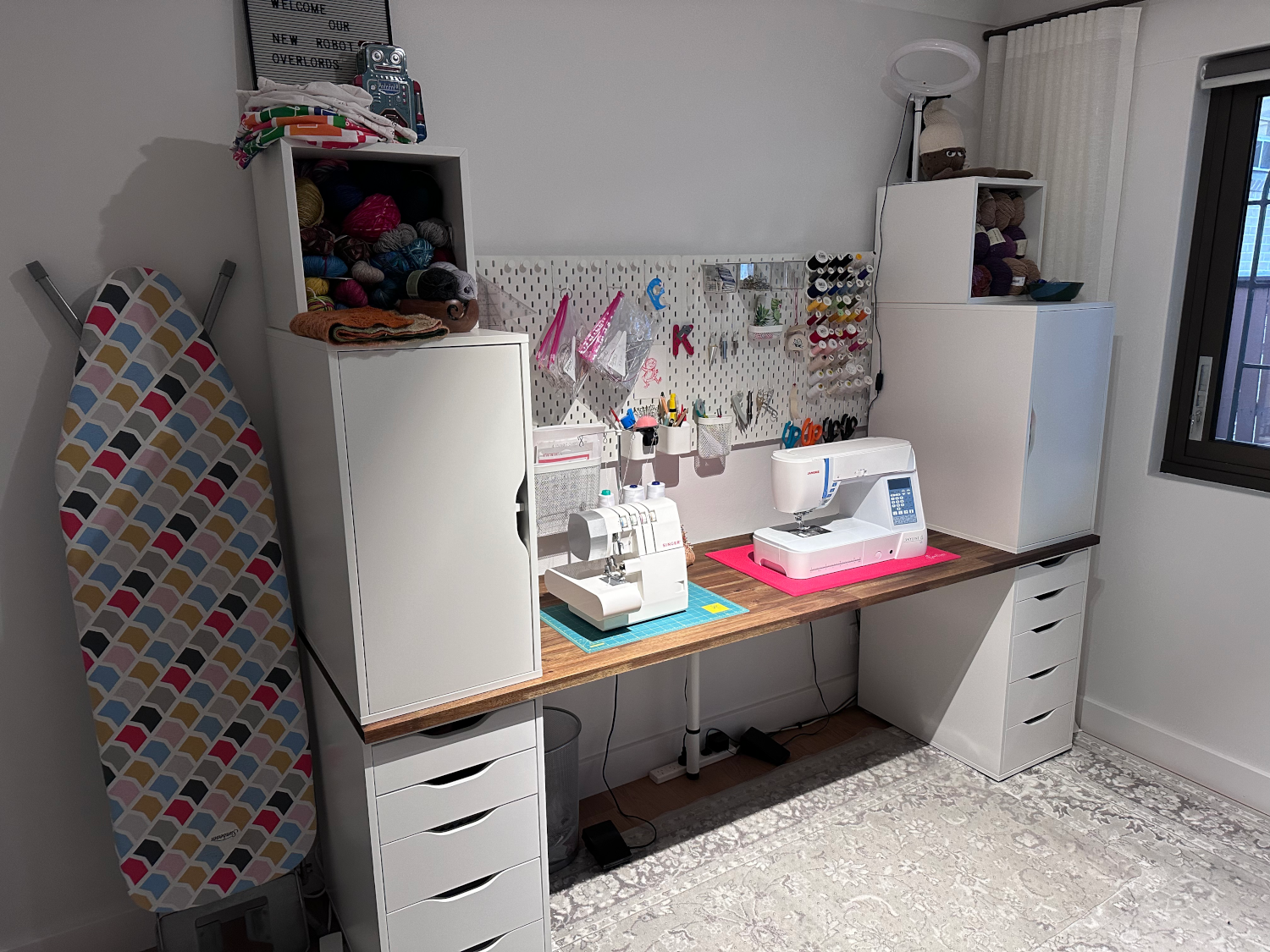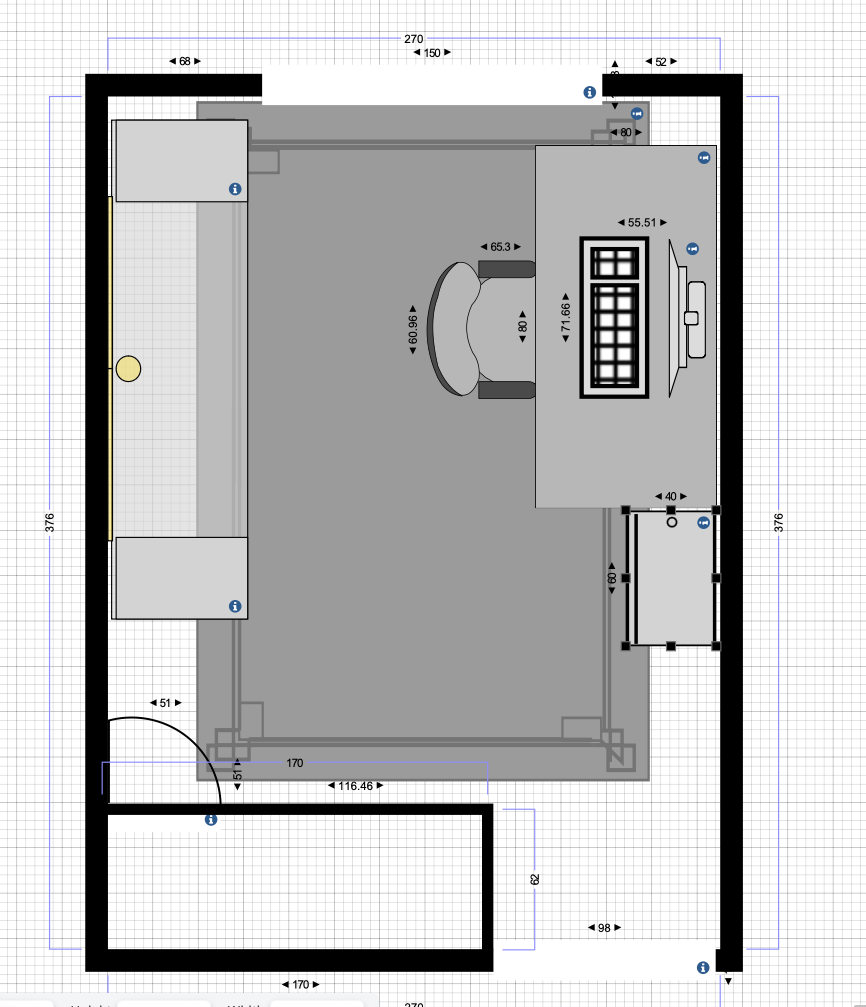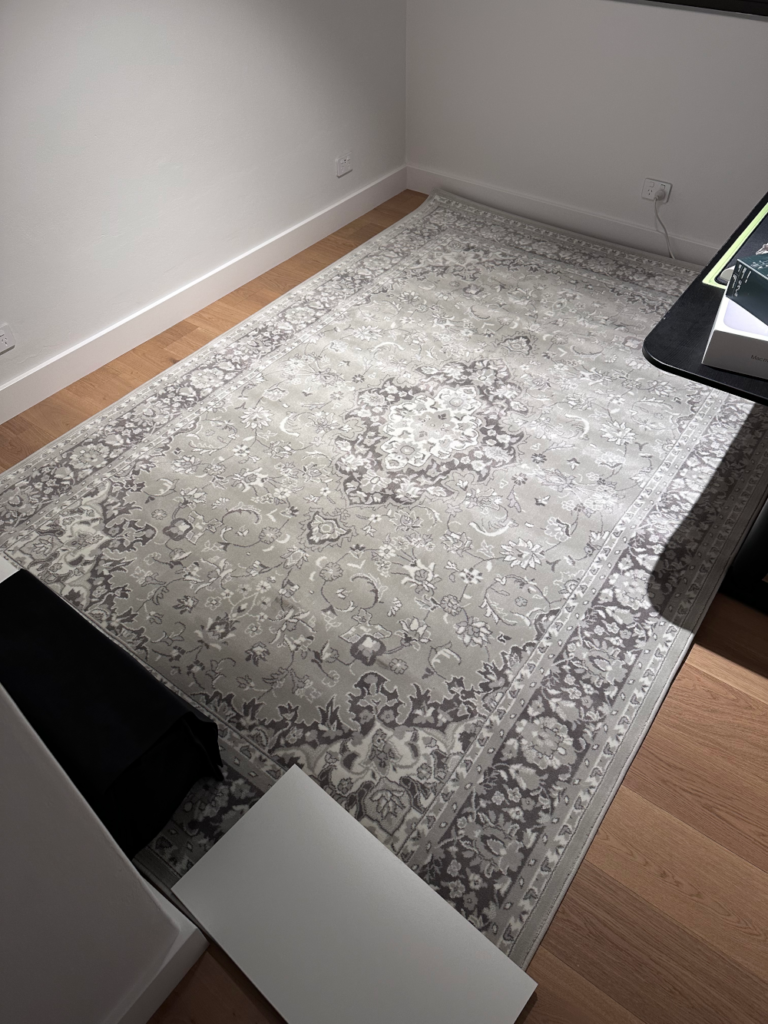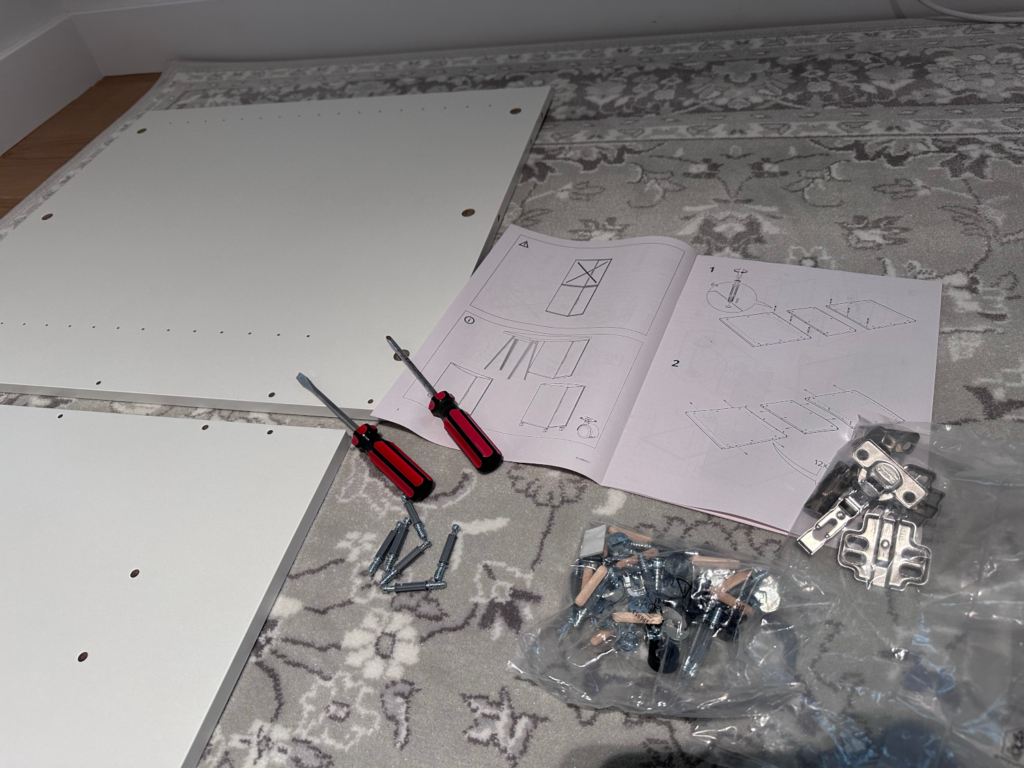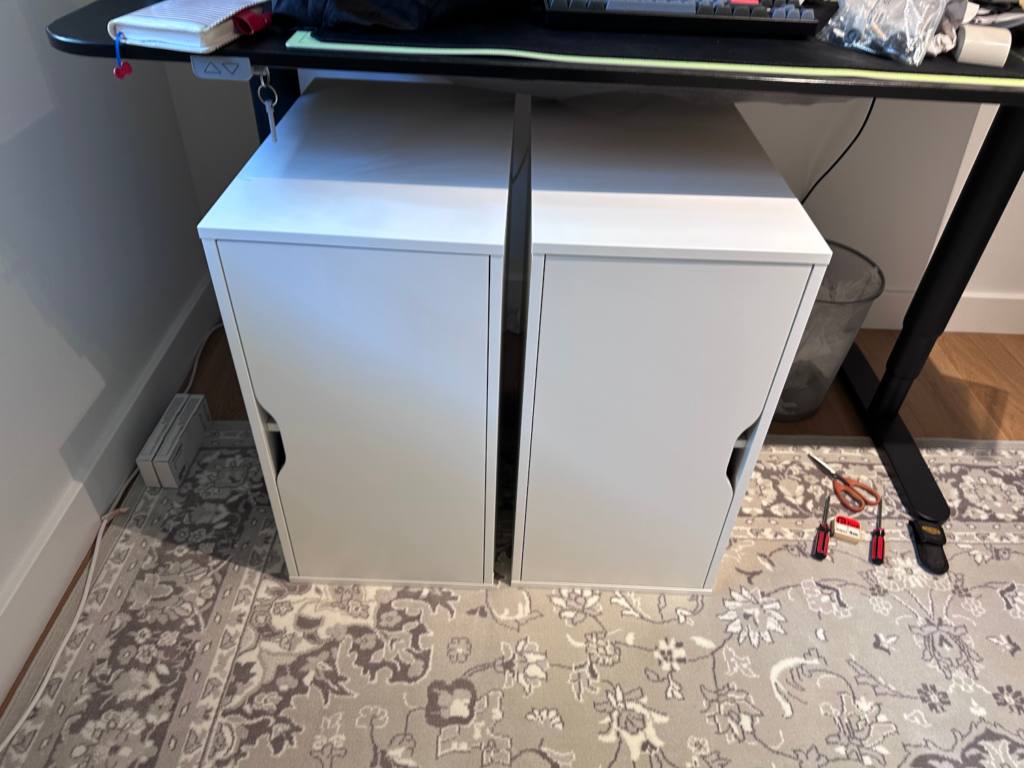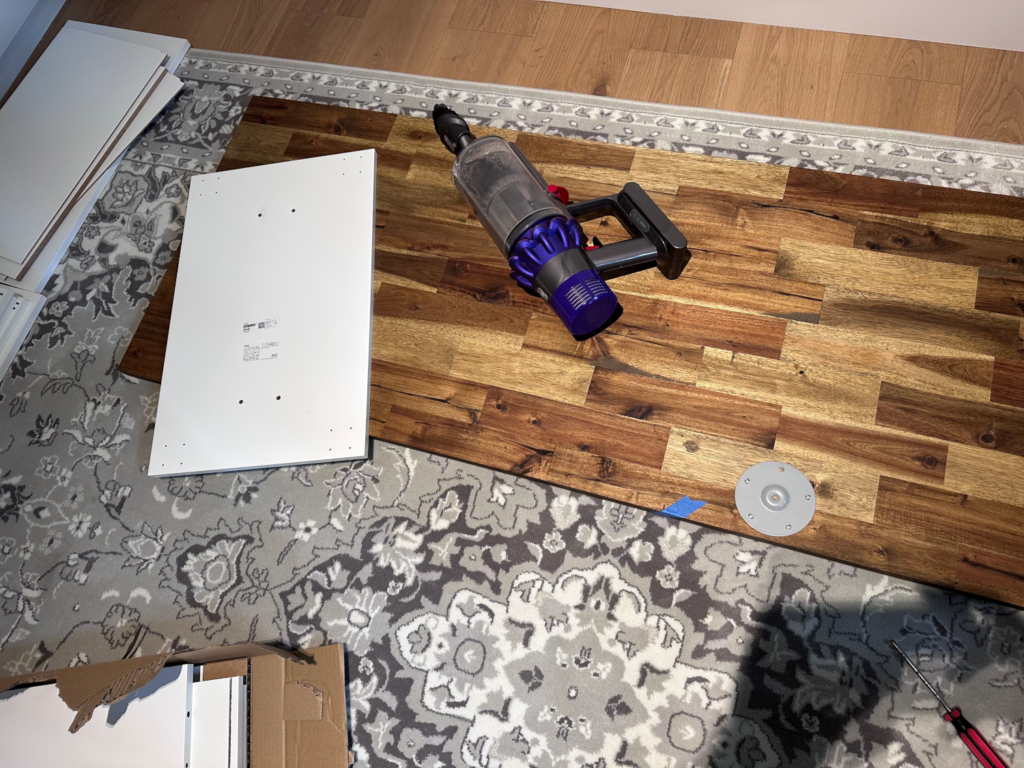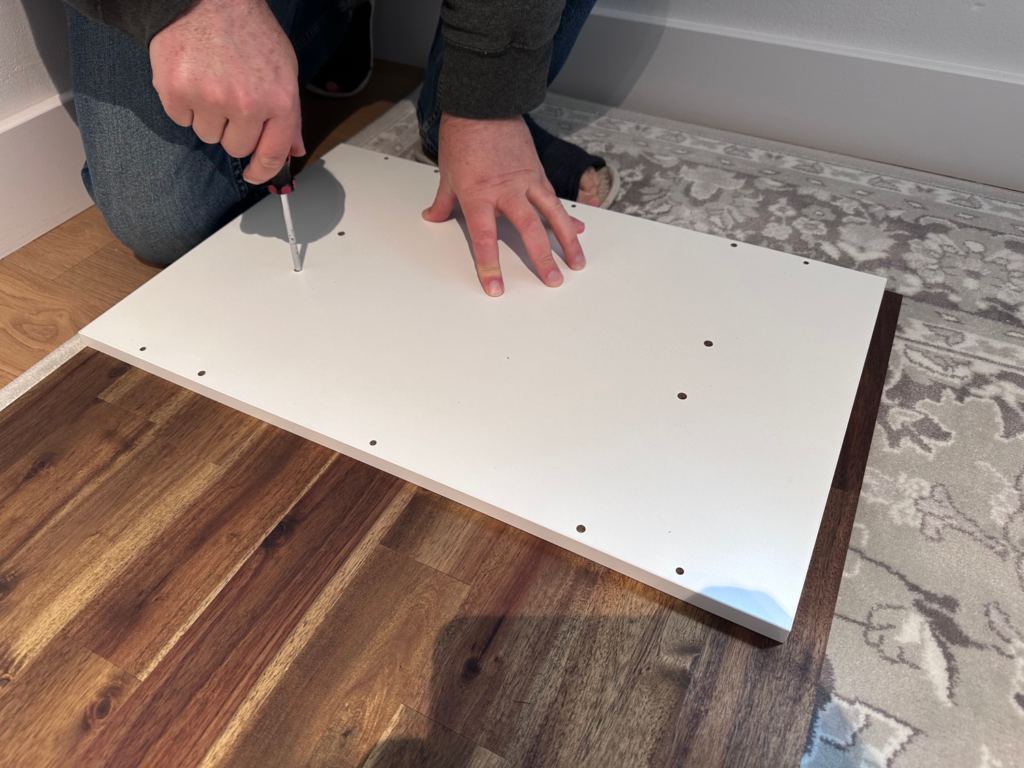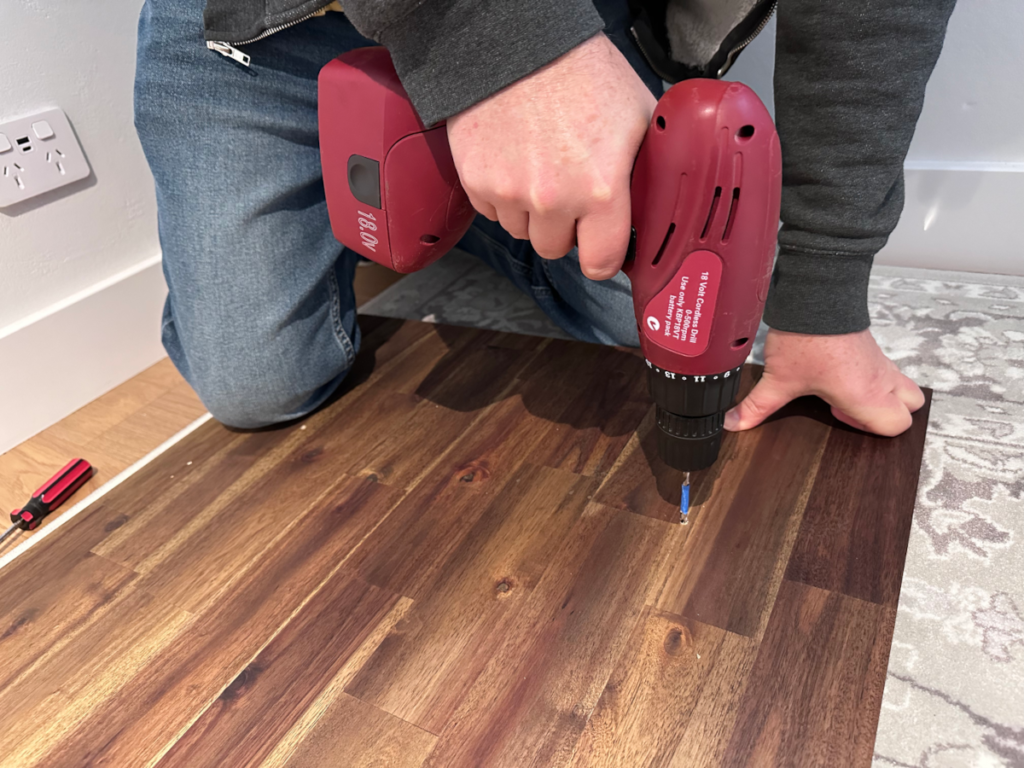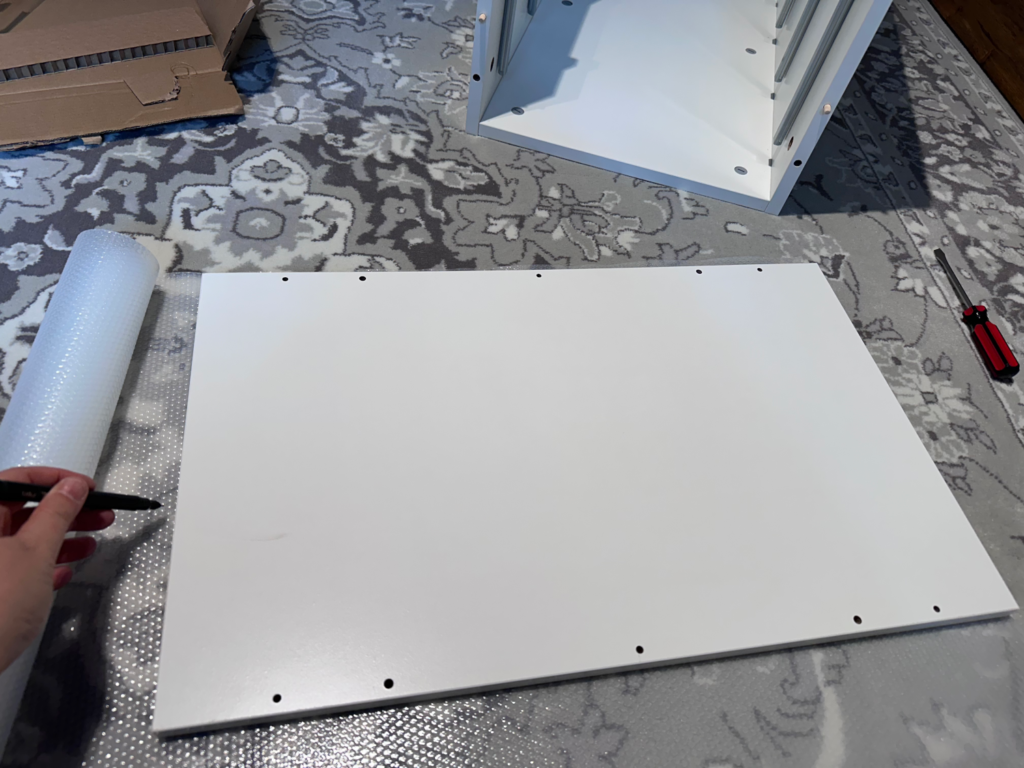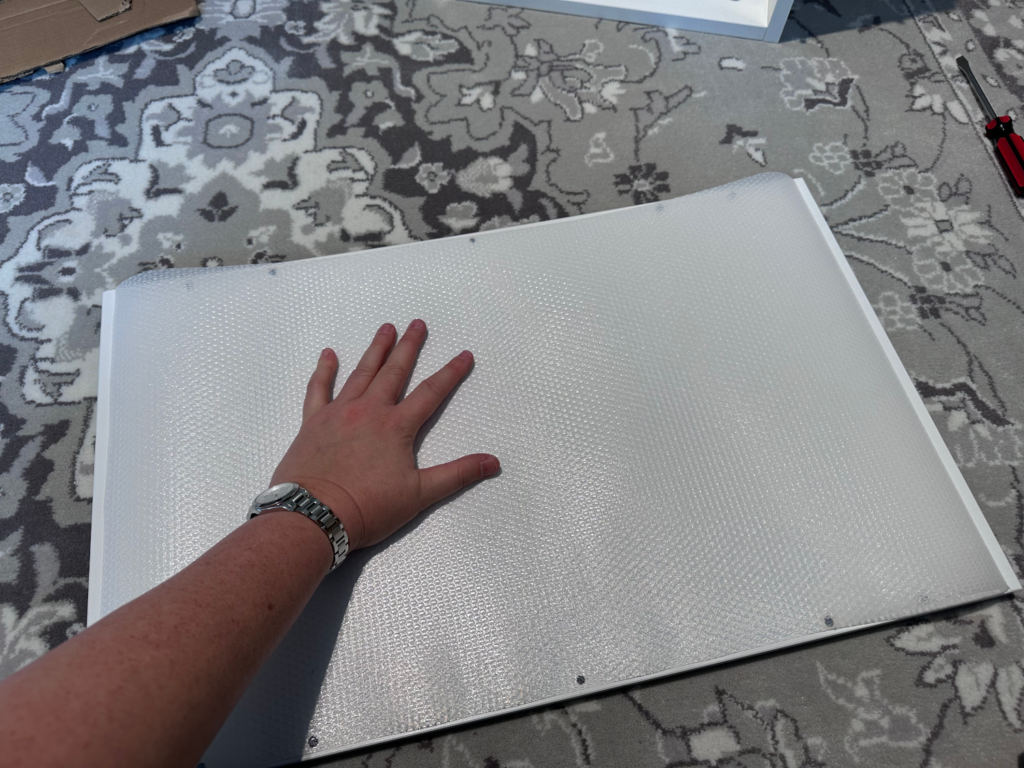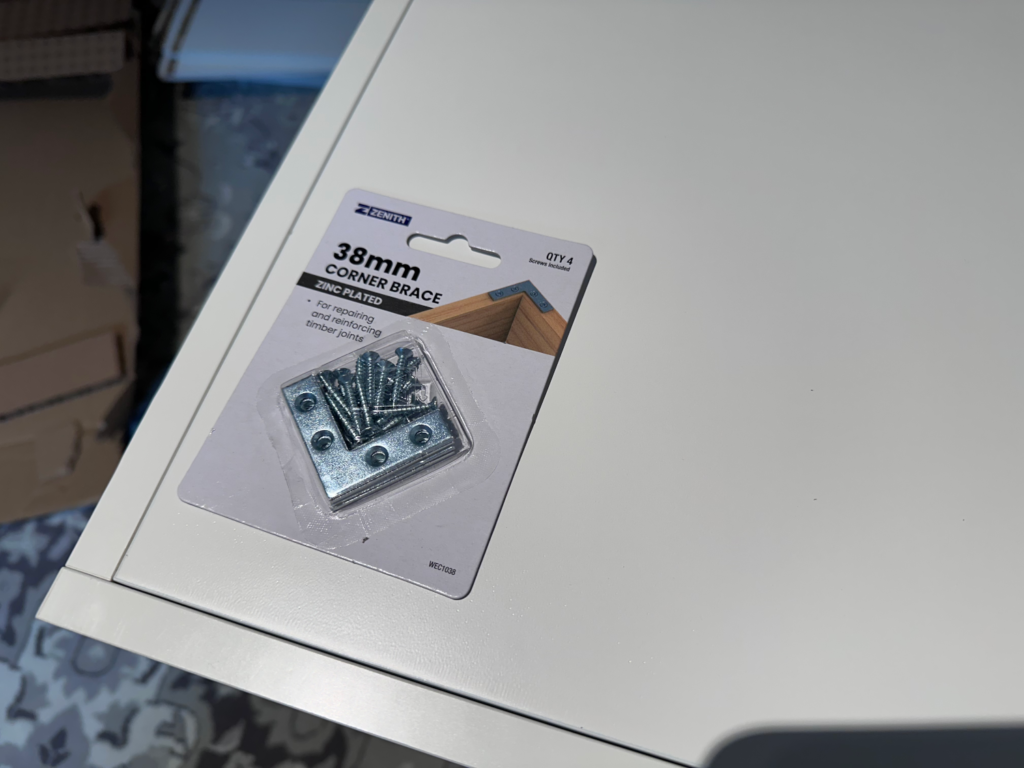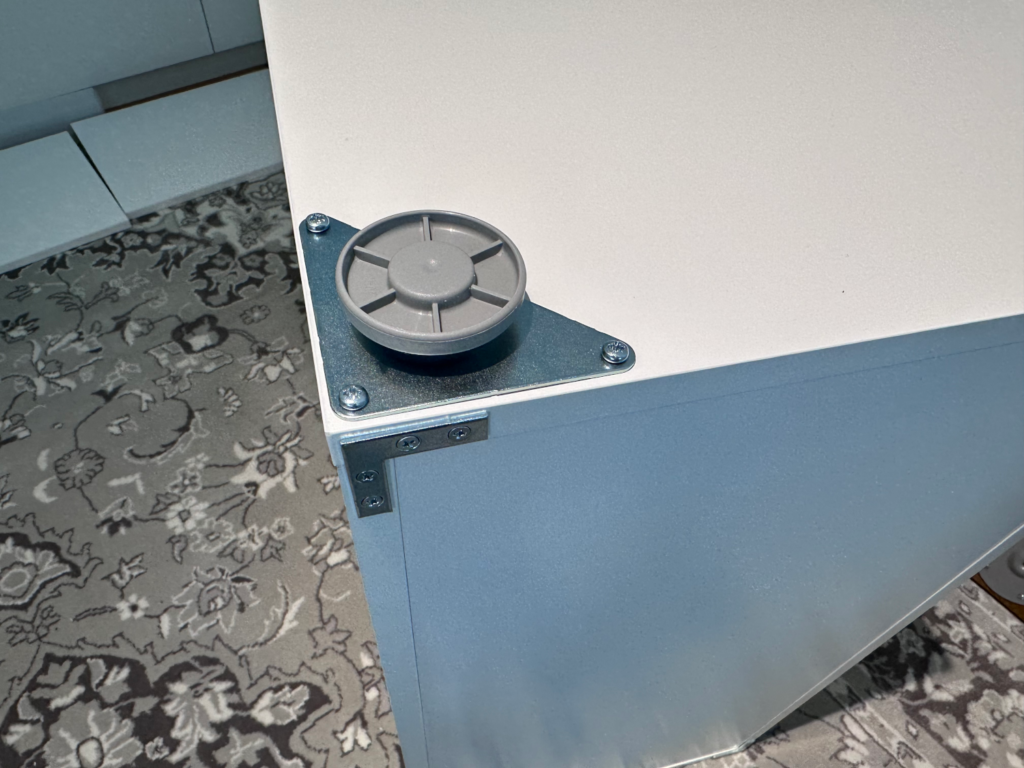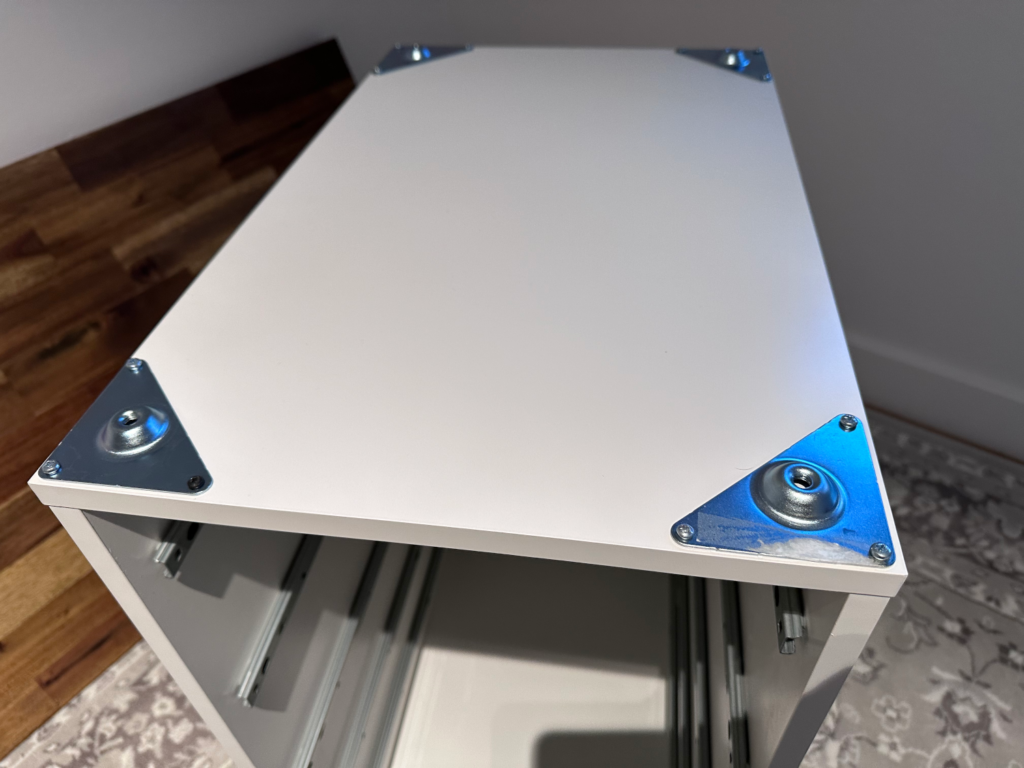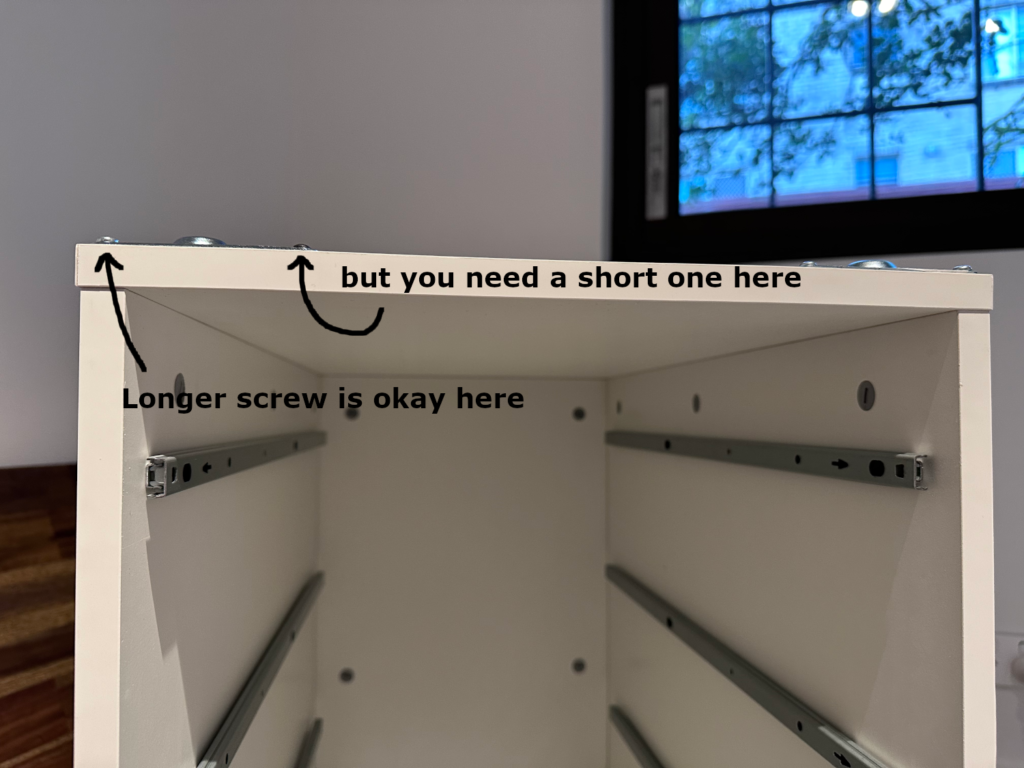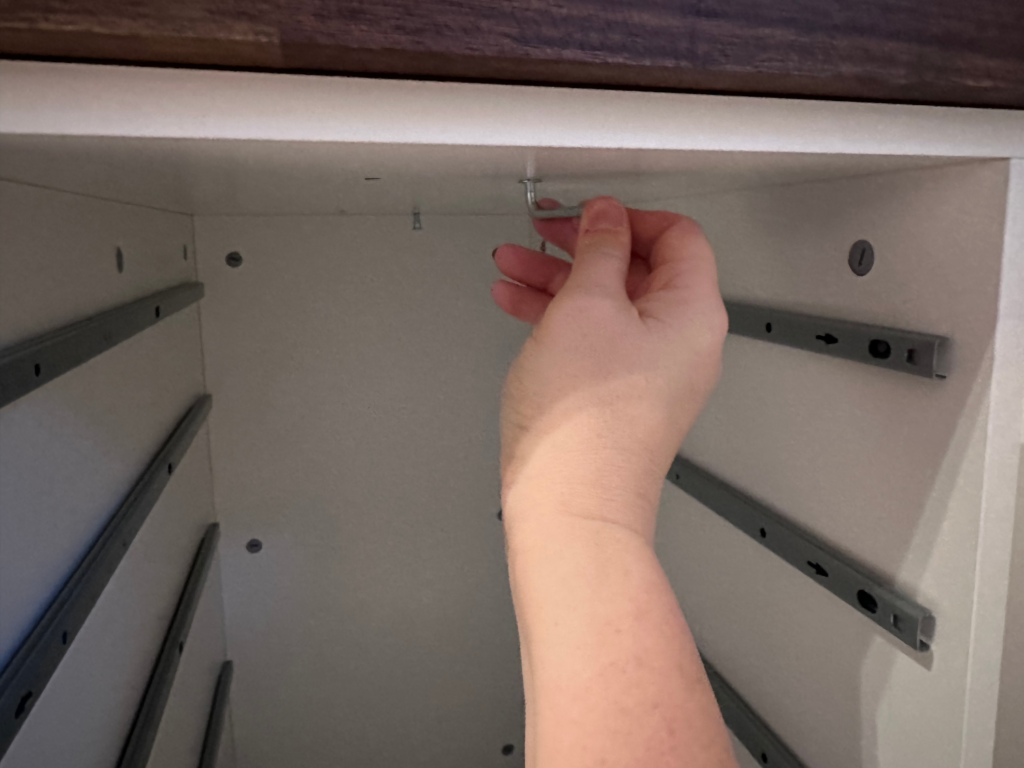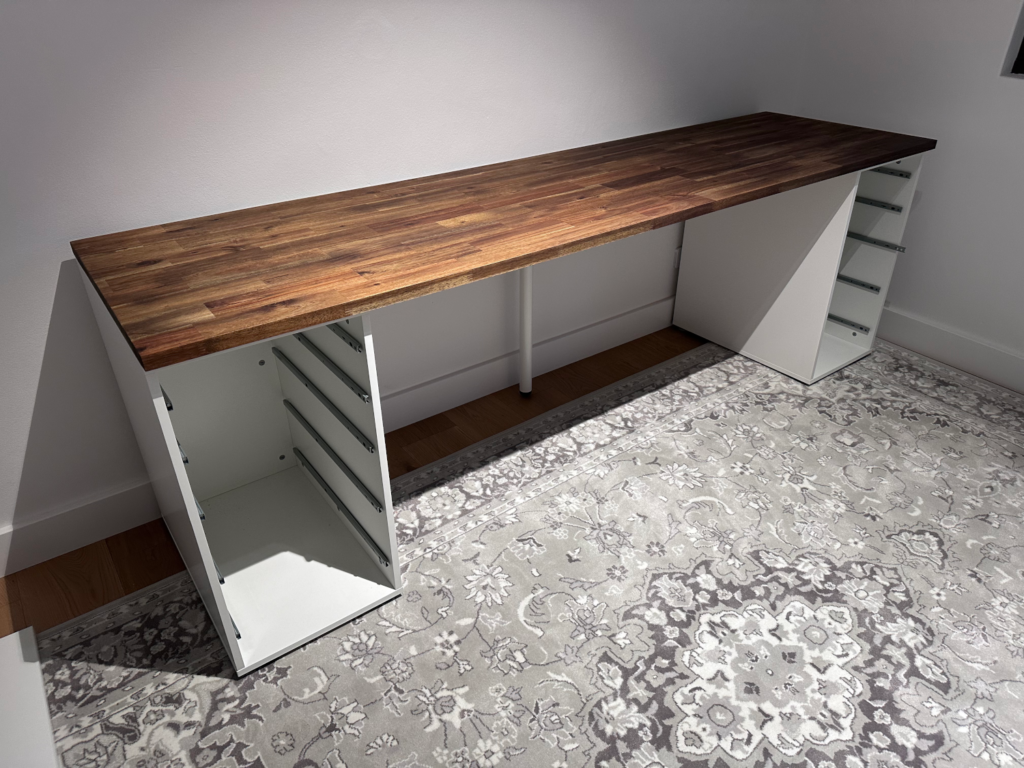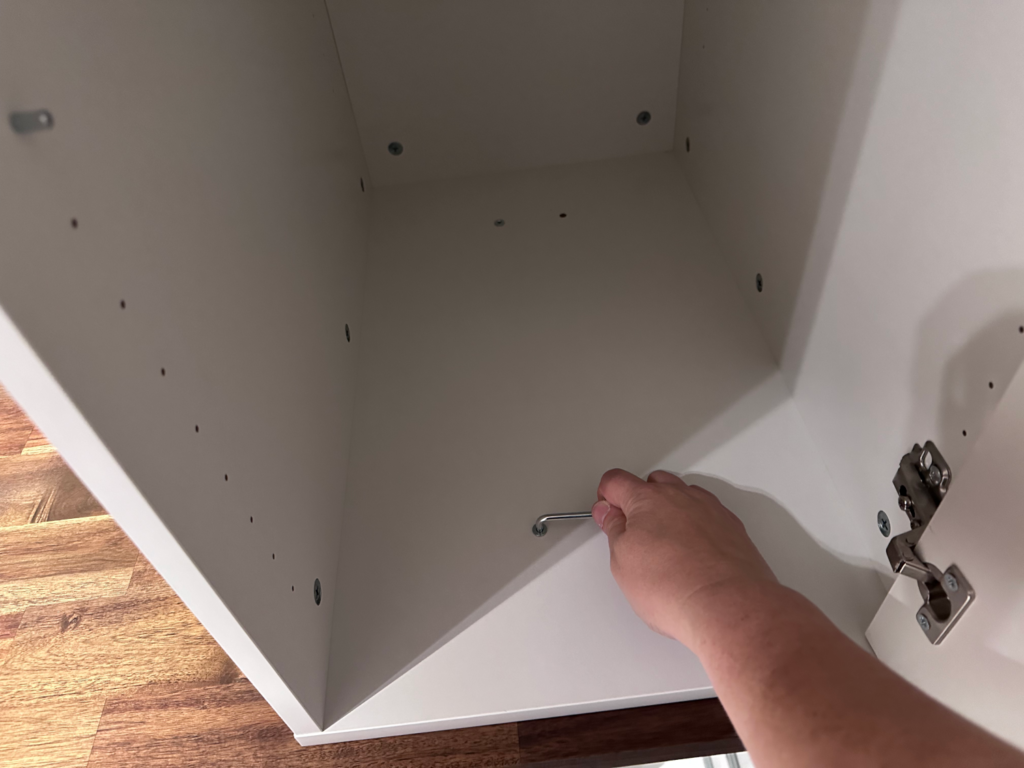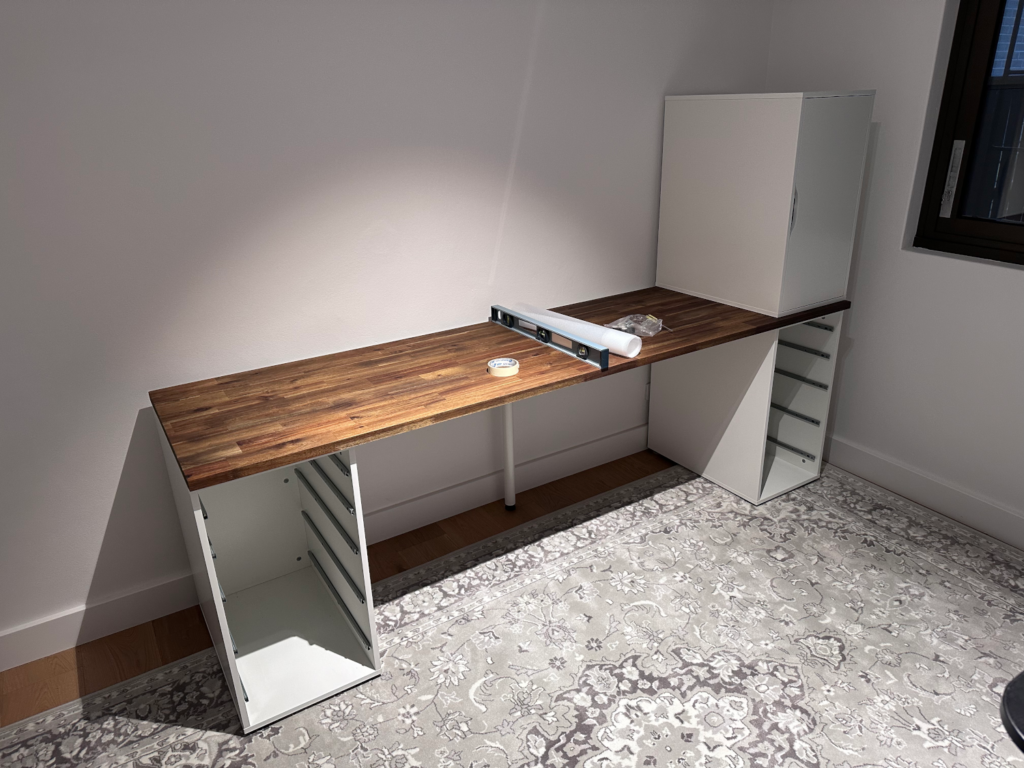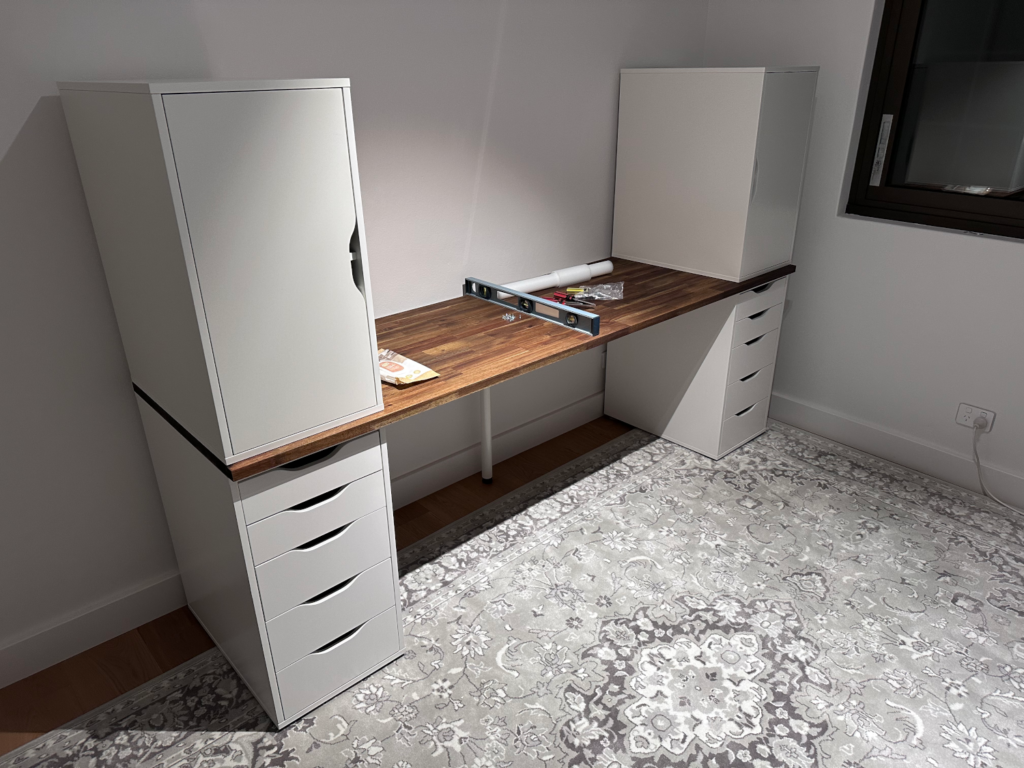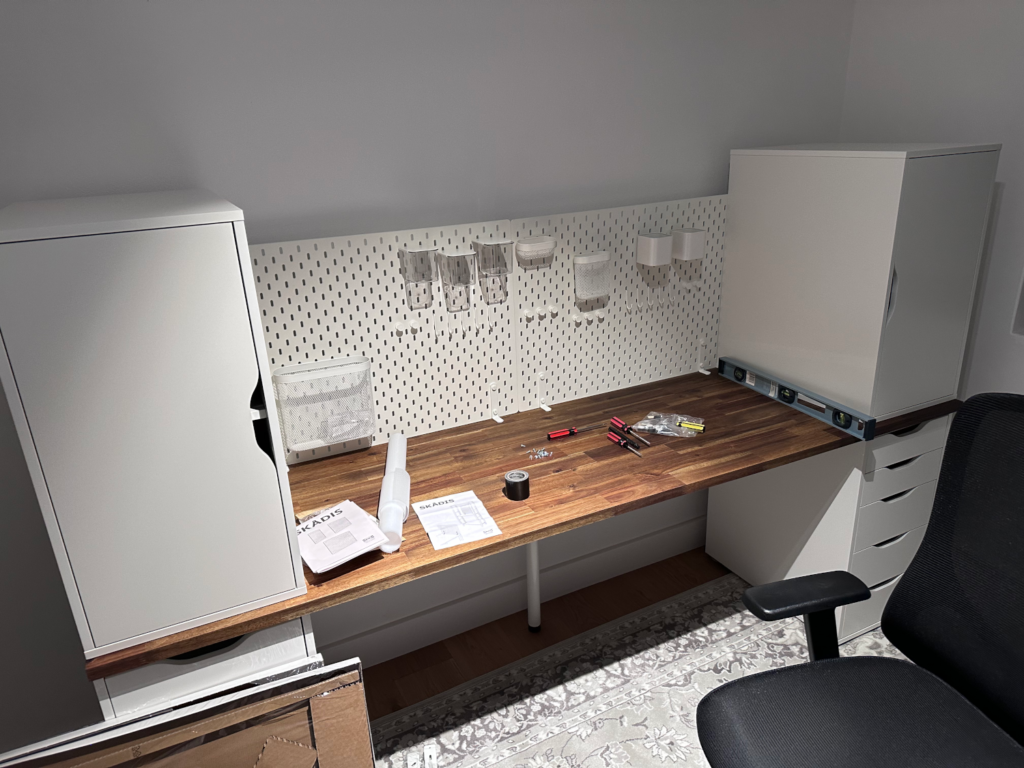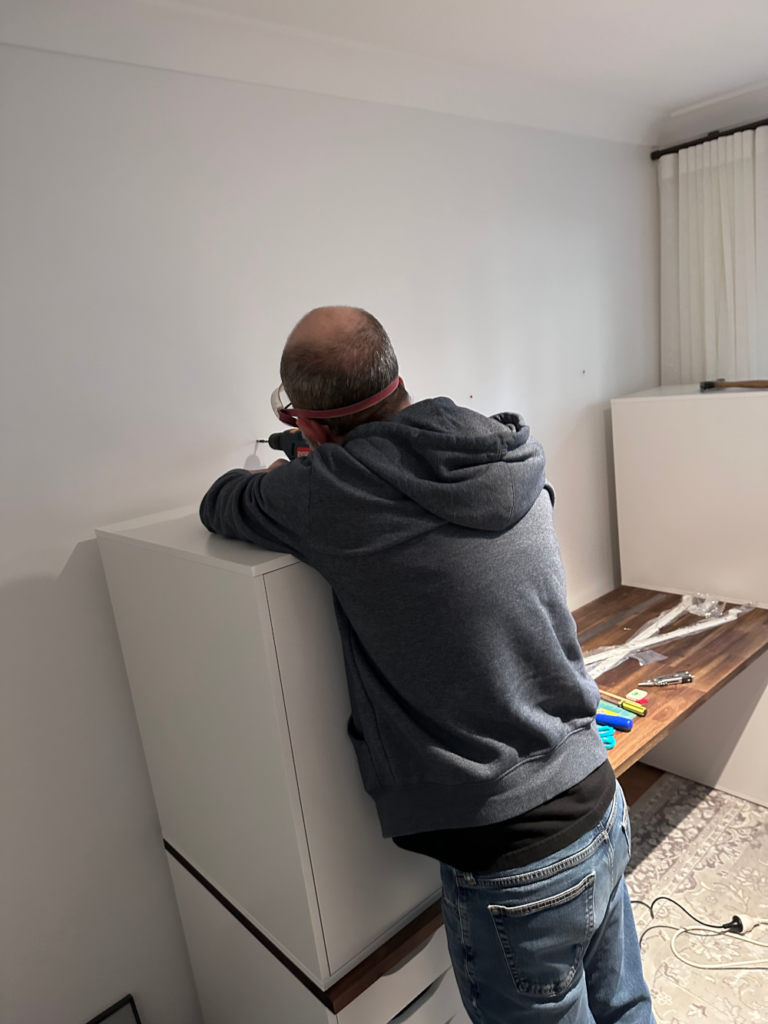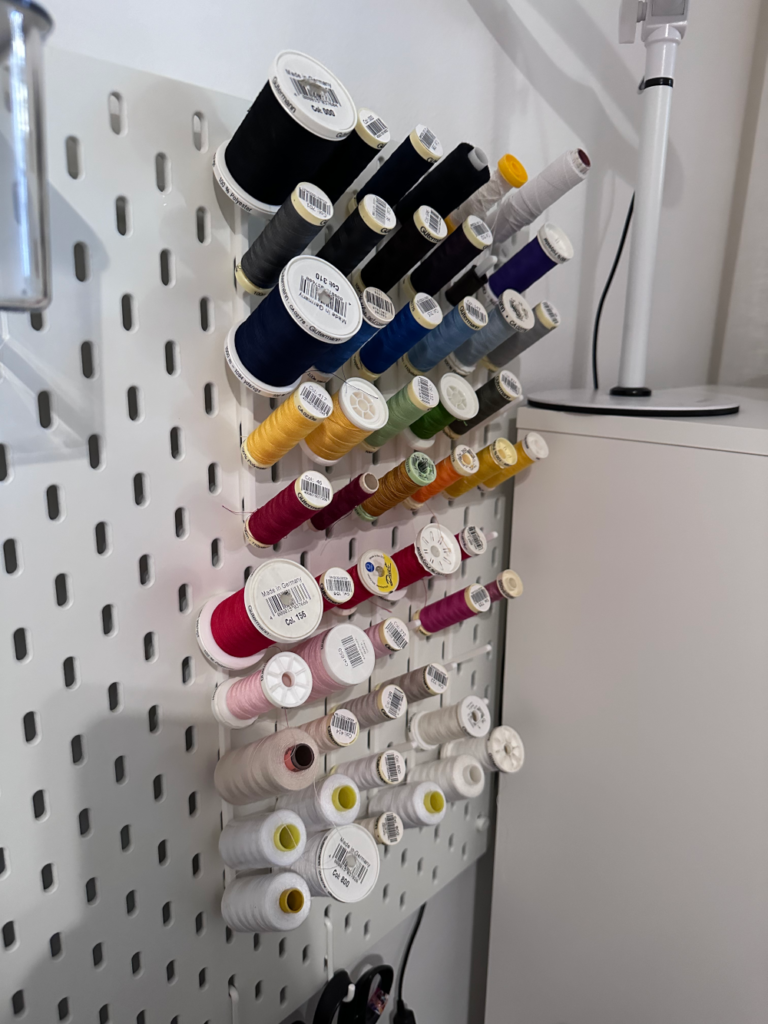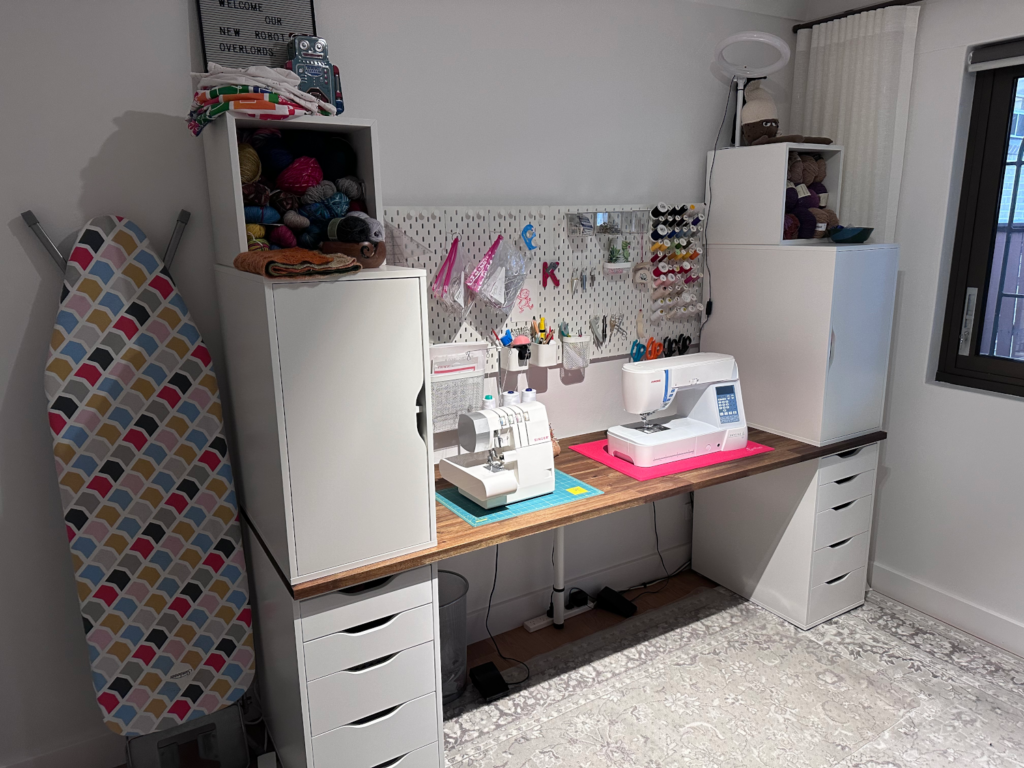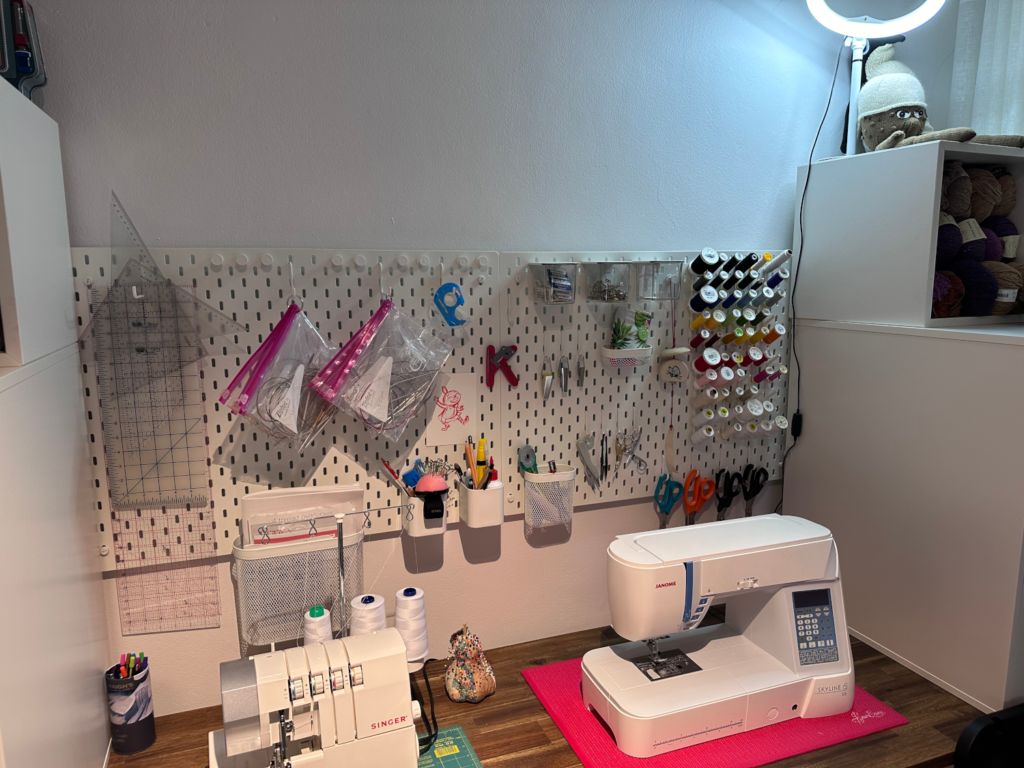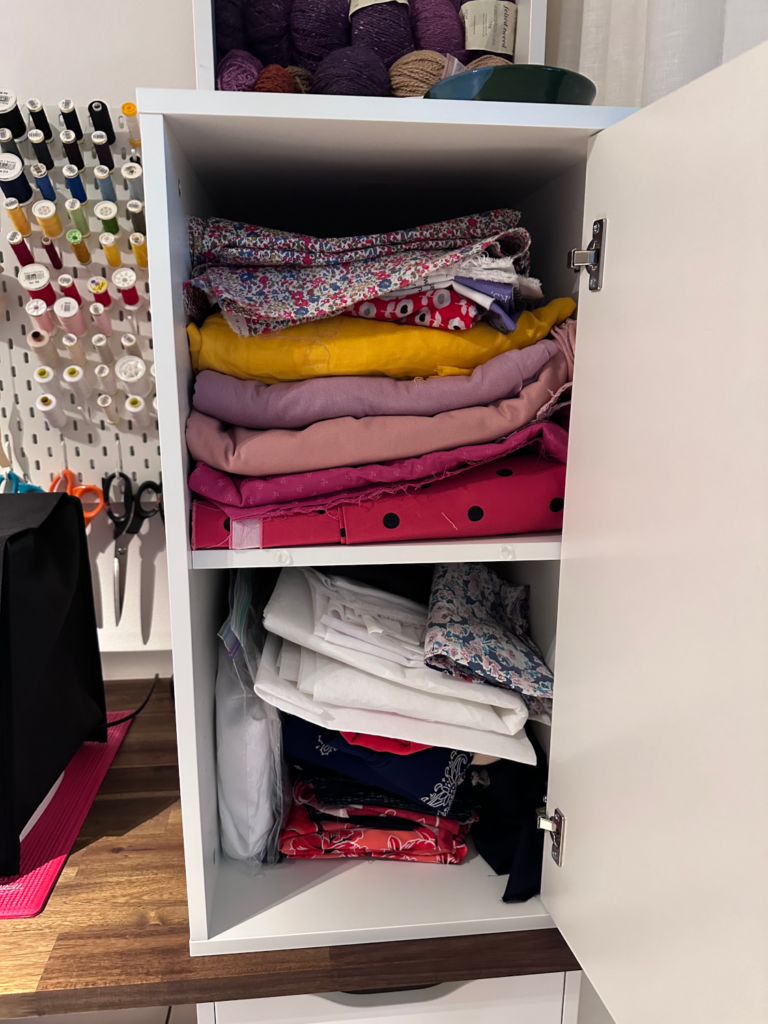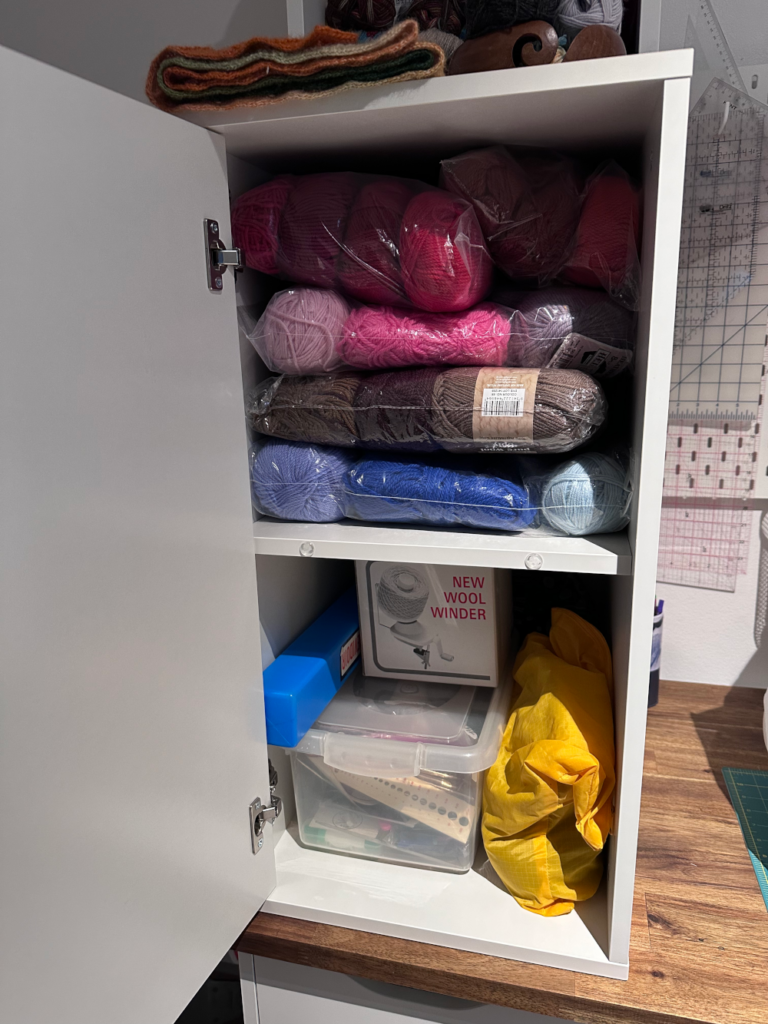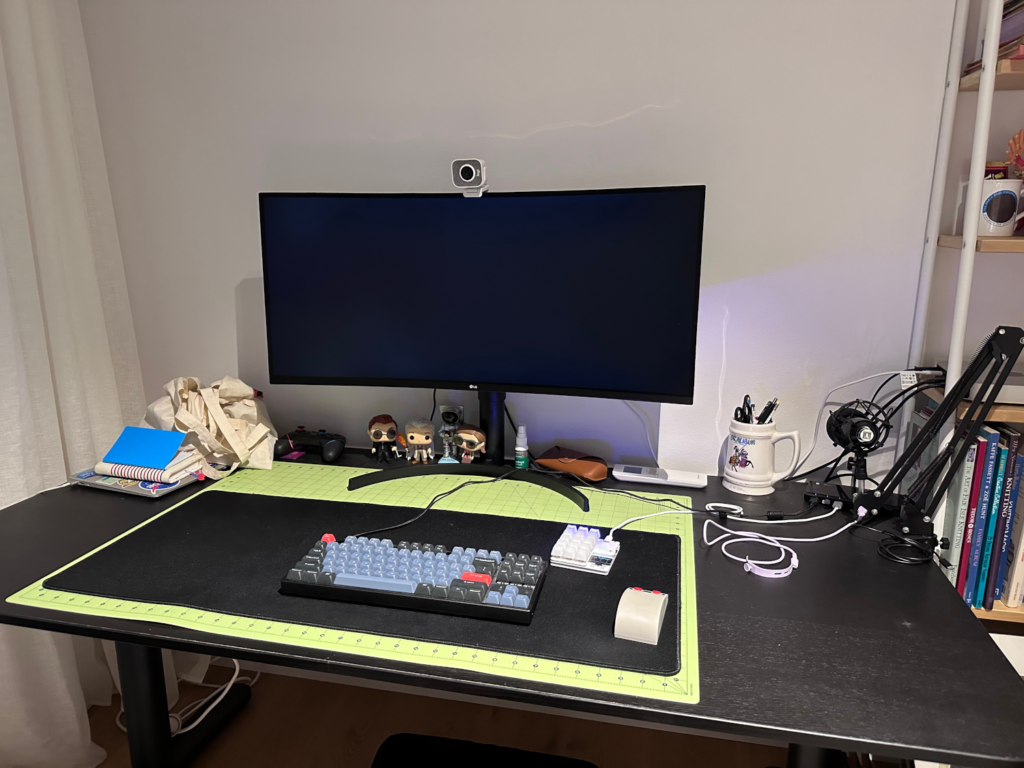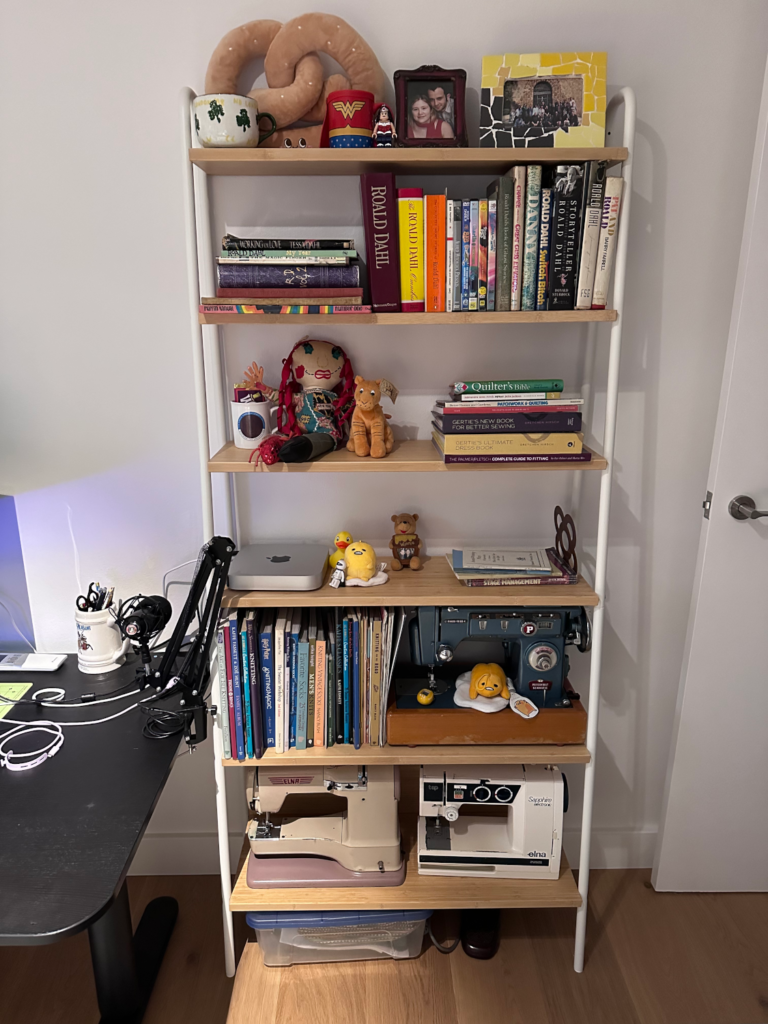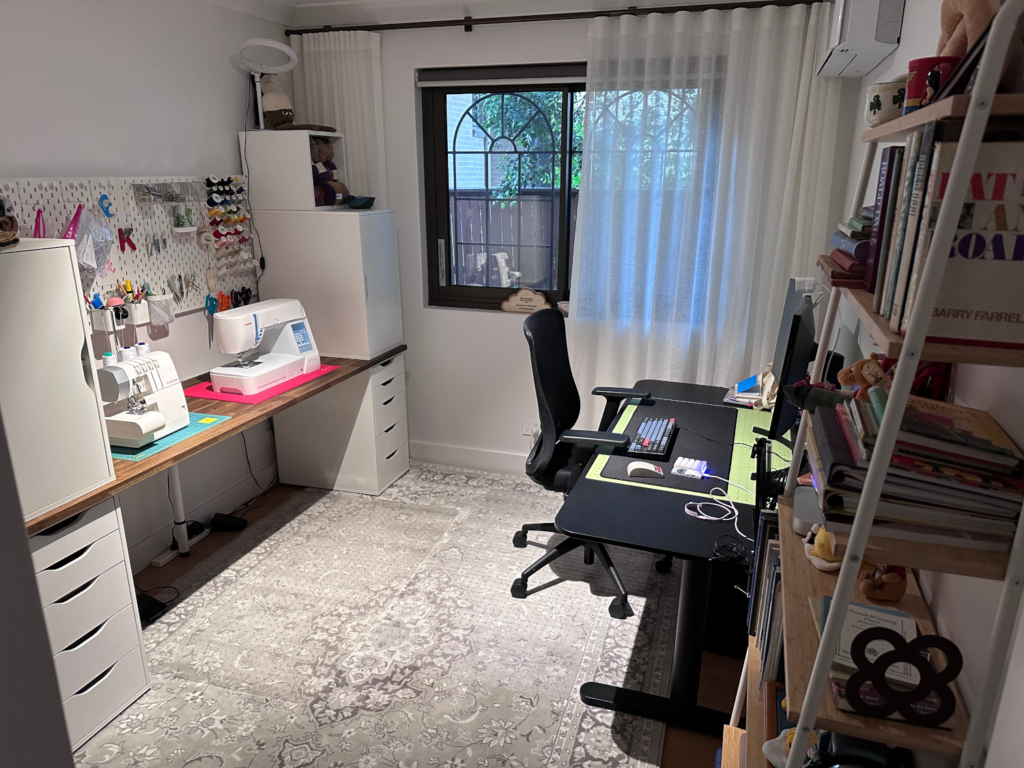In 2024 we embarked on a pretty major home renovation, and once we were moved back in I spent a lot of time thinking about how I wanted to set up my office. I knew that I wanted a dedicated sewing table where I could have both my sewing machine and overlocker set up, with all my tools and supplies in easy reach. I also wanted a cutting table (preferably height adjustable), and somewhere to set up the ironing board for a sewing session. I also needed storage for my fabric and wool.
In terms of assets I had an existing IKEA Bekant standing desk, which serves as my computer workstation but can also conveniently double as a cutting table. I have a large cutting mat that I leave on it, and I can pretty quickly clear away everything when I need to cut something big. I also have a rolling office chair. Beyond that, the room was a blank slate.
I did a lot of googling at what others had done, and I was very inspired by this Garage Workbench DIY. I realised that the IKEA Lagkapten/Alex desk combination was a good starting point, but it had one significant drawback — durability. The Lagkapten has a honeycomb core, and apparently it will sag over time if you put a lot of weight on it. (That’s why IKEA always show a center leg on any of the longer desks.) And guess what? Sewing machines are pretty heavy. I read a lot of posts about people using “stiffening rods” and such to try to reinforce them, but eventually realised it would be a lot simpler to just use an actual wooden desktop. Bunnings make a pre-finished timber panel that I realised would work perfectly. With all that in mind, I used SmartDraw to mock up the floorpan and see how everything would fit.
Once I had the plan, it was time to go shopping! Protip: before you make any major IKEA purchase, check to see if you’re able to access any discounts. We learned that Macquarie Bank sell IKEA gift cards at 6% off, which was a nice savings for not much effort.
Thankfully, we were able to find everything we needed. First step: protect the floor.
I wanted to protect our lovely new wooden floors from the rolling wheels of my chair. This is the IKEA Vedbäk rug. It’s not real wool, but I don’t mind so much in here. We put out an underlay first to keep it from shifting around, and then unrolled the rug. I put some boards and boxes down on it overnight so help it flatten out.
Then it was time to start assembling.
I started with two Alex storage units. Here they are put together and set aside. I made sure that the door openings mirrored each other. The Alex units come with a panel with pre-drilled holes that you can use as the top or the bottom, depending on how you want to set them up. Here I made sure the holes were at the bottom. (You’ll see why in a bit.)
I knew that I didn’t want to just rest the desktop on the units, but instead to bolt everything together so it would be rigid. Before I put the other two Alex units together, we wisely had the idea to use one of the bases to mark out holes for pre-drilling the desktop. We also attached the base plate for the Adils leg. (While I knew my desktop would be strong enough without it, I figured it wouldn’t hurt to have it. We pushed it as far back in the center as we could.)
Here you can see Rodd marking the holes for drilling. The Alex unit bases have 4 holes, and we decided to use the inner set for securing the upper units (on the top side of the desktop), and the outer set for the lower units (on the bottom side of the desktop). That way the screws had no chance of hitting each other. We lined the base up flush with the back and edge of the worktop and used a pointy screwdriver to mark the spot.
Here’s Rodd drilling one of the holes. We worked out the depth needed based on our wood screws and the depth of the Alex base plate, and he put a piece of tape on the drill bit to show him how far to go.
We also had the idea to put something in between the Alex units and the desktop, to add some cushioning and to protect the desktop a bit (in case we wanted to use it for something else in the future). I’m not really sure this step was needed, to be honest. But I bought some of IKEA’s Variera drawer liners and used the Alex bases to cut out appropriately sized pieces.
Here you can see one of the drawer liner pieces, ready for final assembly.
For the bottom supports, I went with two of the Alex drawer units. For these, I made sure that the base with the holes was on the top since we’d be screwing into the desk. I was a little worried about how well they’d stand up to the weight we’d be putting on top (desktop plus another Alex unit). IKEA don’t really seem to recommend stacking them. I decided therefore that a little extra support couldn’t hurt. We bought a couple packs of these corner braces at Bunnings…
And I screwed them into each corner on the back of the Alex drawer units.
You can also see that we purchased Eket feet to use on the bottom units. These are adjustable, so I knew that would help to level the whole thing given that the front would be sitting on the rug. Happily, the screws for the foot base plate didn’t run into the ones for the corner braces. Here’s one of the bottom units upside down. Important note: while you can use longer screws for the outer holes since they run down into the sides, you need to use pretty short ones for the inner one to avoid breaking through the base.
Hopefully this will help illustrate what I mean.
And now it’s finally time to start putting the thing together! We set up the bottom two Alex units, placed the drawer liners on top, and then placed the desktop on top of that. Then I reached up from the inside with a hex key to screw in the wood screws. (These are the ones that come with the Alex and would normally be used to attach it to the Lagkapten top.) I had to first poke through the drawer liner, of course, and then it was a bit of faffing about to get the holes exactly lined up with the ones we predrilled. But eventually I managed to get them screwed in. Remember, on the bottom we secured just the two outer holes, front and back.
Here’s what we had so far. So that’s two Alex drawer units on the bottom, each with reinforced corners (on the back side) and Eket adjustable feet underneath. The desktop is screwed to the top of each from inside the top of the Alex units (using the two outer holes). There’s also an Adil adjustable leg at the center back.
Next it was time to stack the upper Alex units. I put down my pre-cut drawer liners and then carefully placed the upper units. Again, I had to poke through the liner and then laboriously shift things around until I had the holes exactly lined up. But eventually I was able to get each one screwed down, this time using the two inner holes.
Here it is with one upper unit attached…
…and now with both upper units attached and all the drawers inserted!
The space in between the upper units was perfect for two of the Skådis pegboards. We first used some of the connectors to mount them directly to the desktop…
…but I realised quickly that this wasn’t ideal. There was no opening for the power cords for my sewing machines, and because the pegboard was so low I really couldn’t make full use of it. So the Snook kindly broke out his hammer drill and helped me mount the pegboards directly to the wall.
And this is my favourite thing of all. I discovered that some nice person designed a sewing thread spool holder that fits the Skådis pegboards, and which can be 3D-printed. My awesome friend Bobbie printed a dozen of them for me, which allows me to store 60 spools of thread!
And here’s the end result! Raising the pegboard makes it much more useful, and allows me to run the power cords down the back of the desktop. My sewing machine sits on a special vibration mat that it came with, and the overlocker is sitting on a spare cutting mat. I picked up a couple Eket cubes off Facebook Marketplace that I simply stacked on top of the Alex to add some additional storage for all my prettiest wool skeins. I’ve also got a ring LED light that I can turn on to add light when I’m sewing. And the ironing board can be stored and set up on the left, with a power strip down at the bottom to plug in the iron.
I bought a bunch of the different Skådis accessories to hang and store my tools. I’ve had a lot of fun figuring out the most efficient place to put things! I also organised my circular knitting needles by size into Ziplock bags, which I then threaded onto split key rings and hung from a hook. Very tidy!
The upper right Alex unit has my fabric stash, with scraps on the bottom and project-sized pieces on top. (Not pictured are the two giant boxes of old fabric that I donated to The Sewing Basket. 😬 I’m working on hoarding less stuff, and making sure that what I have is useful.)
On the left is my stash of knitting wool and supplies. This is the utilitarian wool, while the prettier stuff is in the Eket boxes on display. (Again, I donated a bunch of old stuff to charity.)
For the sake of completeness, I’ll show my desk as well. It’s got a large self-healing cutting mat, and on top of that I have a large gaming pad under my keyboard, mouse, and duckyPad. My Mac Mini sits on the bookshelves next to the desk, and I’ve got a USB dock in that corner where all my stuff is plugged in. When I want to use the desk as a cutting table, I can pretty quickly shove everything back in that corner and raise the desk up to a comfortable cutting height. Depending on how big a piece I’m cutting, I may not even need to move the monitor!
I also managed to fit in a Svenarum shelving unit alongside my desk. I especially like how it gets thinner towards the top, which helps feel like it’s not crowding the doorway too much. This allows me to show off my vintage sewing machines (the bottom two belonged to Rodd’s grandmother and mother), as well as my craft books and some of my Roald Dahl collection.
And here’s the finished office/craft room! In the Alex drawers, I’ve got various sewing supplies all stored on the right side (buttons, trims, zipper, tracing paper, etc). On the left is general office and crafting supplies. I’ve got two plastic floor protectors over the rug that allow me to roll my chair easily from the desk to the craft station. I’m really happy with how it’s turned out. Together with the closet, I’ve got ample storage for all my projects and everything I need is within arm’s reach.

